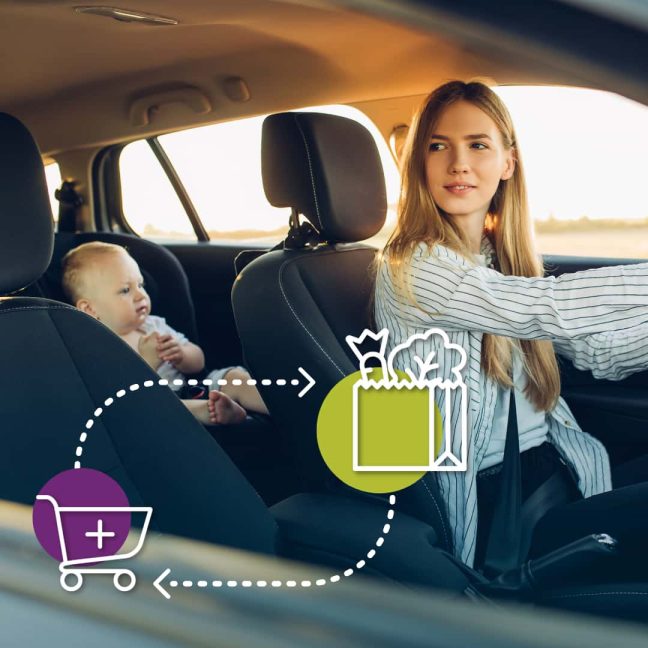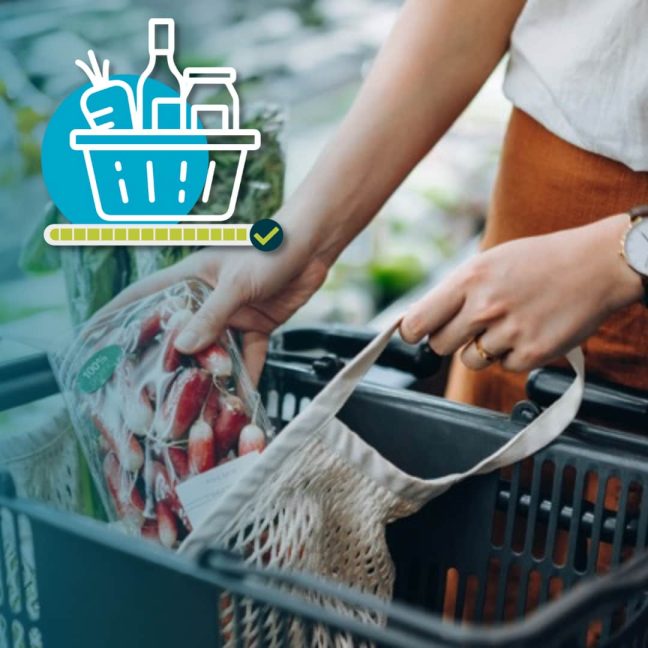Sponsored content

By Mark Fairhurst, VP of marketing, Mercatus Technologies Inc.

As VP of marketing at Mercatus, Fairhurst leads the development of the company’s overall marketing and brand strategy and related programs. He’s also co-host on “The Digital Grocer” podcast and brings to the show a marketer’s perspective on the rapidly evolving grocery tech landscape. He applies a strategic lens focused on a continual search for the next big trends and best practices.
Fairhurst enjoys exploring not just how things are changing in grocery retail, but also why they’re changing – and where they’re headed. Prior to Mercatus, he held senior marketing positions at leading business software companies including GS1, Solera and Intelex.
Five issues omnichannel grocers need to address this year
To achieve success in grocery retail, it’s necessary to operate a truly omnichannel business, one that spans in-store, online and mobile with equal facility and efficiency. An omnichannel business offers the choice and convenience that shoppers now demand, and omnichannel shoppers purchase more than single-channel shoppers – making it highly desirable to capture this market.
But a successful omnichannel enterprise requires grocers also to have ownership over the experience that is their customers’ shopping journey. With greater control of their e-commerce channels, grocers are empowered to preserve margins and grow customer loyalty by ensuring a consistent brand experience and importantly retaining all customer data.
Let’s look at some of the key areas omnichannel grocers need to focus on for the remainder of 2023, so you can better understand where you should channel your resources in the months ahead to end the year on a high note.
A mobile grocery shopping experience
With mobile increasingly becoming the preferred way to shop, it’s become a critical component of every grocery retailer’s omnichannel strategy.
A grocery mobile app helps to build loyalty, improve share of wallet and win market share – as long as it provides an elevated level of convenience and delights customers. Essential features in a grocery mobile app include:
- Modern mobile framework – This will enable best-in-class features and functionalities, smooth integrations with third-party apps, quick and seamless innovation to continue evolving with the industry and the ability to scale as needed. To watch for: frameworks with Application Programming Interface (APIs) integrations or Software Development Kits (SDKs), which support new functionalities that enhance the customer experience.
- Seamless navigation – A great shopping experience requires an intuitive app that makes it easy to navigate the digital store and easy to build a basket, review the order and check out. The app should provide different ways to build the cart, such as accessing promotions, flyers or coupons from the home screen or by digitally strolling the aisles.
- Robust content management system (CMS) – Shopping apps need to be constantly refreshed with new images, promotions, flyers, coupons, deals and private-label products. The app must also be aligned with your website and other channels – a must-have for a truly omnichannel shopping experience.
- End-to-end ecosystem – Users need to be able to shop in the way that works best for them, which may include a single session completed on multiple devices. When your web and mobile platforms are seamlessly integrated, shoppers can conveniently continue their session on another platform without interruption.
Now is the time to take a critical look at your mobile app and to ensure that you’re serving up the best possible mobile commerce experience for your grocery brand.
Personalization and customization
With inflationary pressures continuing, many shoppers are more cost conscious, and it’s likely they’ll remain so throughout 2023. At the same time, a plethora of grocery ordering options, with new entrants arriving constantly, means they have more choice. It’s more important than ever to find ways to retain your customers and build long-term loyalty.
Incorporating personalization into your omnichannel strategy is a proven way to do this, bringing more value to the shopping experience and solidifying customer loyalty.
Personalization can add convenience to the shopping experience in many ways. For example:
- Personalized product recommendations make it easier for customers to find their most-purchased products and add them to their cart in a single click.
- Personalized searches offer tailored search results by predicting what a shopper might be looking for based on their purchase history.
- Personalized rewards and offers provide an attractive cost incentive that drives shoppers back to you, boosting your share of wallet.
Personalization helps you establish a stronger relationship with your customers, one that’s built on trust. When you serve up information customized to each shopper, you tell them that you know them and want to help them — and that’s the basis of long-term loyalty.

Customer retention
While building long-term loyalty is the ultimate goal, you don’t want to lose sight of any customer attrition that may be happening. A good way to get a handle on this is by looking at cart abandonment patterns in your omnichannel experience.
It’s easier for shoppers to walk away from a shopping cart in the online world than in the real world. The result can be a loss of both revenue and customer loyalty – if they leave today, will they return tomorrow?
Refining your omnichannel experience to discourage abandoned shopping carts should be an ongoing part of your strategy. There are some key steps you can take:
- Analyze metrics – Track where in the shopping experience carts are abandoned, so you can surmise why customers are leaving early, and target these areas for improvements.
- Be up-front about fees – The checkout page is a common area for customer drop-off. Make sure you are transparent from the earliest point in the visit about the fees and extra costs to reduce abandonment due to checkout “sticker shock.” At Mercatus, we recommend that our clients encourage shoppers to book their fulfillment time slot up front, so they know what the actual pickup or delivery fee will be and are more likely to complete the order.
- Review fee strategy – You may also want to revisit your overall strategy for pickup and delivery fees. For example, are there certain days or times that you can reduce or eliminate fees to help fill slack periods? Lower or no service fees may be more important to some shoppers than getting their groceries faster. In the Omnichannel Shopper Behavior Report 2022 (Vol. 2) from Mercatus, for example, we found that just over half of shoppers would wait longer to receive an order to save on fees.
- Create a seamless checkout – Whether they’re shopping on desktop, tablet or mobile, consumers want a quick and easy checkout process that’s free of surprises. The checkout flow needs to be intuitive, with the ability to review and easily change or add to the order, plus a range of payment options.
- Optimize your site – Shoppers can be turned off enough to leave if your site is slow to load or times out, if the search function makes it hard to find a desired product, if product descriptions or nutritional information are inaccurate or incomplete, or if a product photo doesn’t match the description.
Assessing new trends
With the rapid pace of technological advances, there’s always something new and exciting emerging. Is it a flash-in-the-pan, or will it be an industry game-changer? That’s something grocery execs are constantly assessing. Mobile e-commerce, for example, has clearly emerged as a must-have – the numbers behind shopper uptake provide ample evidence in support of this.
Over the past six months or so, there’s been a lot of hype about generative AI. It’s a disruptive force that has already been incorporated into major search engines, and tools such as ChatGPT have grocers pondering how they can incorporate it into their own platforms – if they should at all.
It’s important to remember that it’s still early days, and there’s much more to be learned about how and when to use these tools safely and effectively.
Tools like ChatGPT are being used successfully to write marketing content like emails and social media posts. Those who are using them well have mastered the skill of writing a prompt that gets the results they need. These tools can also be used for internal purposes, like educating employees about your business, or facilitating the work of help desk staff by enabling them to rapidly access information so they can respond to inquiries more quickly.
If you plan to use generative AI tools, you’ll need to ensure they’re not inadvertently releasing trade secrets, confidential company information or personal identifiable information (PII). Data and privacy must be vigilantly safeguarded. And while AI tools can speed up your workflow, be sure to check all output carefully.
Monitoring KPIs
Measuring success requires, well, measurement. For 2023, it may be time to revisit what metrics you are collecting to ensure you have the key performance indicators (KPIs) you need to understand where you are succeeding on your omnichannel journey and where you need to improve.

While some traditional metrics, like basket size, have a direct and equally meaningful equivalent in the digital world, others, like sales per square foot, do not. Here are a few of the KPIs of particular relevance to the omnichannel grocer, and which we recommend that our clients track:
- Customer lifetime value (CLTV);
- Cart abandonment rate;
- Customer satisfaction score (CSAT); and
- Fulfillment cost per order (CPO).
All of these are critical indicators of success and warrant careful attention.
Mapping a plan for the remainder of 2023
These are all important issues that grocers need to confront sooner rather than later. A key advantage of a first party grocery e-commerce platform is that you can control the factors that influence your omnichannel success. By developing a strategy now that addresses these issues, you’ll be on your way to a successful close to 2023 and a strong start to 2024.
Mercatus helps leading grocers get back in charge of their e-commerce experience, empowering them to deliver exceptional retailer-branded, end-to-end online shopping, from store to door. Our expansive network of more than 60 integration partners allows grocers to work with their partners of choice, on their terms. Together, we enable clients to create authentic digital shopping experiences with solutions to drive shopper engagement, grow share of wallet and profitability, and quickly adapt to changes in consumer behavior.
The Mercatus Integrated Commerce platform is used by leading North American retailers, including Weis Markets, Save Mart brands, Brookshire’s Grocery Company brands, Kowalski’s, Buehler’s Fresh Foods, WinCo Foods, Smart & Final, Stater Bros. Markets, Fresco y Más, Harveys Supermarket, Winn-Dixie and others. Mercatus is headquartered in Toronto, Canada.
To read more from The Shelby Report’s Industry Leaders, click here.

